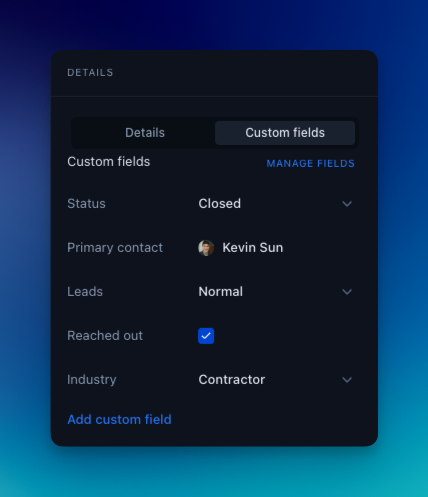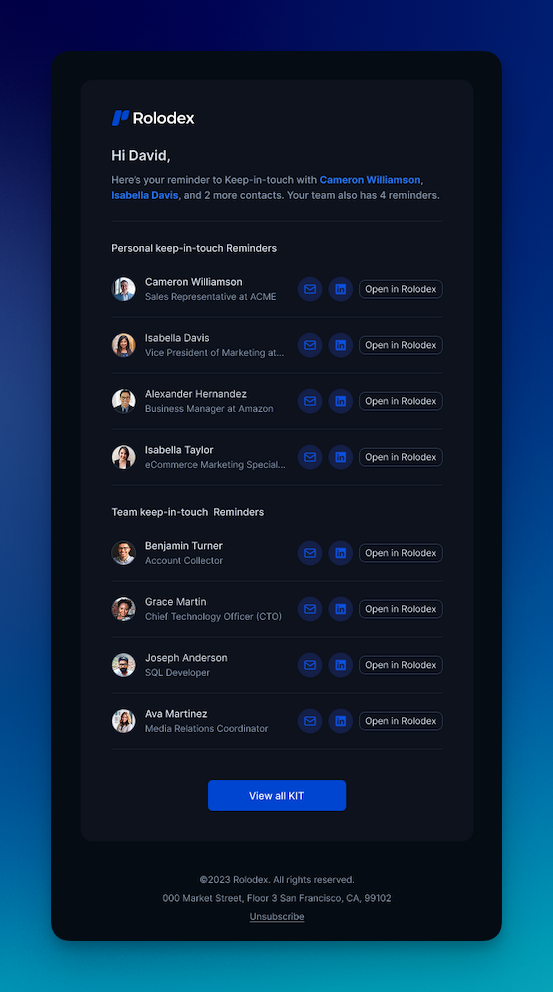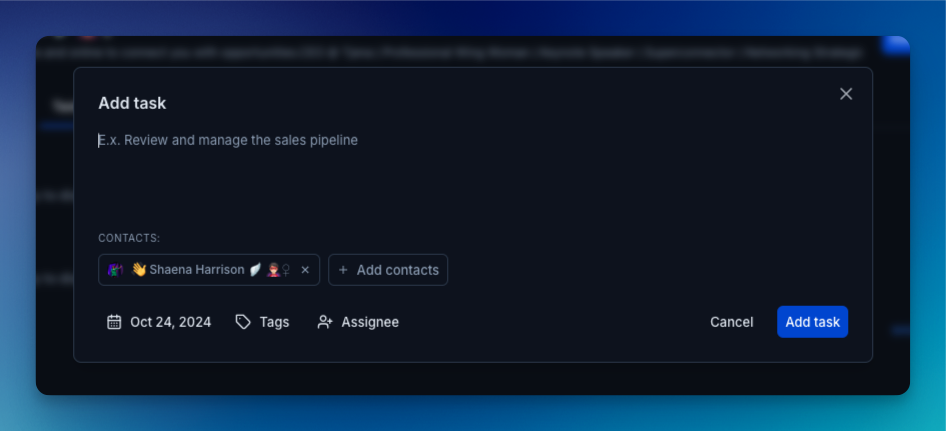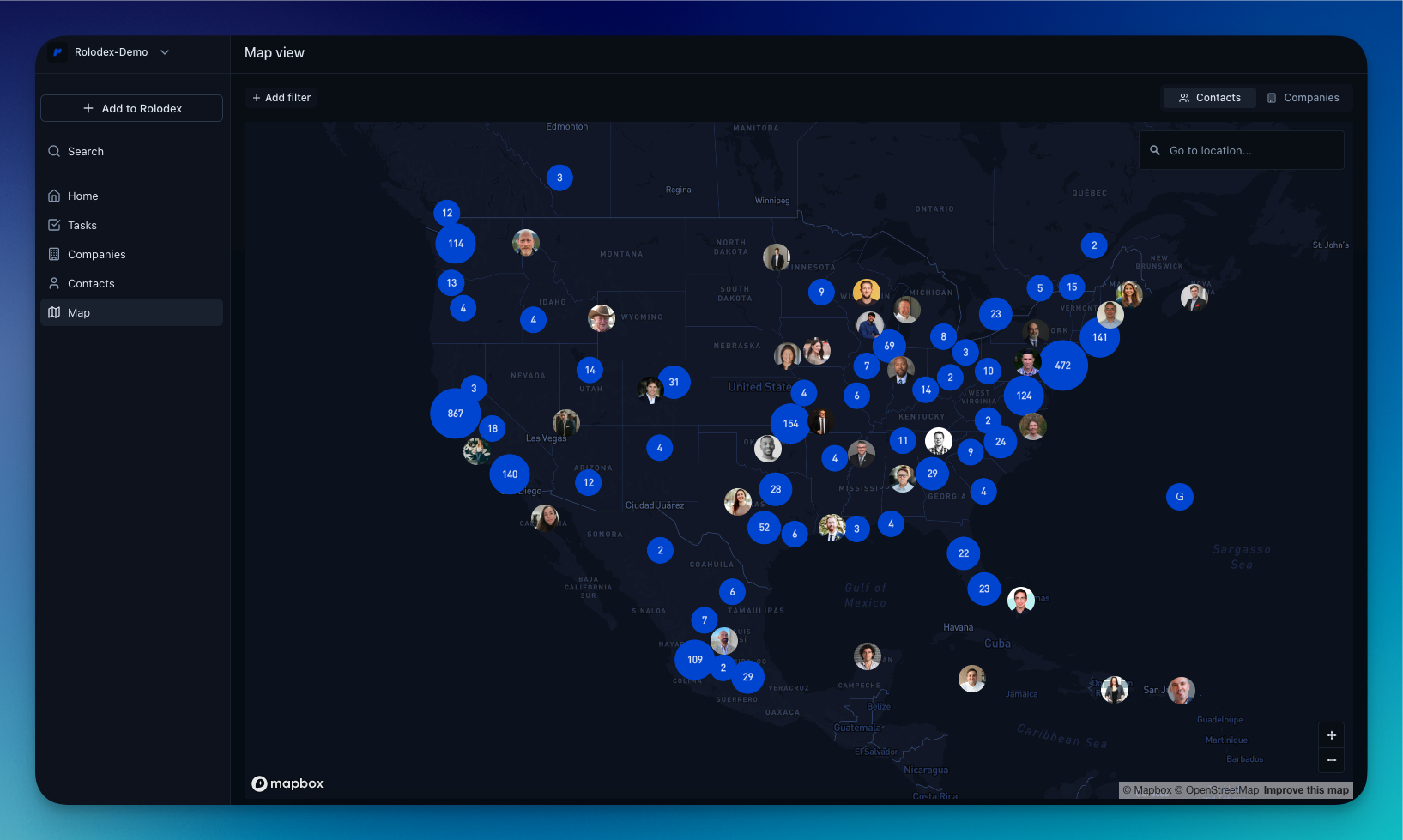Rolodex is designed to help you and your team collaborate around your shared network in a unified workspace. Instead of relying on siloed spreadsheets, forgotten introductions, or disconnected notes, Rolodex brings together every meaningful relationship—past, present, and future—into one intuitive platform. The goal? To bring together your collective connections, organize them effectively, and maintain strong, ongoing relationships with the people and companies that matter most.
By syncing your team’s emails, LinkedIn connections, and calendar activity, Rolodex builds a consolidated view of your contacts and companies.
From there, powerful tools like custom fields, tasks, and boards help you stay organized, while features like Keep in Touch ensure your most important relationships never slip through the cracks.
This article walks you through the core features in Rolodex and how they work together to create a powerful workflow for relationship intelligence—centered around four key actions: Consolidate your network, organize your network, stay informed, and manage your network.
Consolidate Your Network
At the core of Rolodex is your shared workspace. By connecting LinkedIn, Gmail, and Outlook accounts across your team, Rolodex automatically consolidates everyone’s contacts and communication history into one centralized platform—eliminating silos and manual upkeep.
Rolodex organizes your relationship data into two core entity types:
Contacts
– Individual people pulled from LinkedIn, emails, and calendar events
Companies
– Automatically generated based on where your contacts work
This creates a unified, living relationship database that gives your entire team visibility into who knows who, how you’re connected, and when the last interaction occurred.
Many teams—and especially individuals—still rely on spreadsheets to keep track of their relationships. While spreadsheets offer structure, they quickly become outdated, require tedious manual updates, and are nearly impossible to collaborate on effectively. With Rolodex, that burden disappears. Every new email, meeting, or LinkedIn connection is automatically synced into the platform, keeping your network up to date without lifting a finger (though manual entry is always available if needed).
Our LinkedIn integration also enhances your contact profiles with rich professional data. With just one click, Rolodex’s pulls in key details from a contact’s LinkedIn profile, including:
LinkedIn bio
Work experience
Education
Location
Profile photo
Current title
The result? A dynamic and collaborative view of your team’s network—fully enriched and always up to date.

Organize Your Network
Create Strucure
Lists in Rolodex are a flexible way to organize contacts and companies around specific initiatives, stakeholders, or priorities. Whether you're managing outreach, tracking investors, or coordinating an event, lists provide a shared space for your team to take action and stay aligned.
You can create as many lists as you need, and each contact or company can appear in multiple lists—giving you full flexibility to group and regroup your network as your priorities evolve.
Here are some common examples:
Key Relationships
— Centralize the most important contacts across your team
Investors
— Track who you’ve pitched, who’s warm, and who needs a follow-up
Prospects
— Organize leads into lists based on relevance, geography, or stage
Portfolio Companies
— Keep investor-facing company details accessible to the team
Event Planning
— Add attendees or speakers for easy outreach and coordination
Personal Follow-ups
— A simple list like “Mary’s Outreach Prospects – May 2025” is just as useful
Lists are fully visible across your workspace, making them a powerful tool for collaboration. You can monitor updates in real time, share notes, and use the list as a springboard for workflows like Boards, Keep-in-Touch reminders, or task assignment.
By taking time to thoughtfully build lists around your shared network, your team creates structure that unlocks speed and clarity down the line. And since Rolodex allows a contact or company to belong to any number of lists, there are no constraints—only context.
A contact might appear in both “Investors” and “People in Texas Who Like Golf”, depending on what matters to your team. Rolodex doesn’t limit how you organize your network—because real relationships aren’t one-dimensional

Build a Smarter Network
Your relationships don’t fit into a one-size-fits-all mold—neither should the way you manage them.
Rolodex allows you to create custom fields for both contacts and companies, giving your team the flexibility to model your relationship data around how you actually work. These fields let you go far beyond the basics, transforming Rolodex into a tailored relationship intelligence system for your team.
You can create custom fields of the following types:
Text
— For storing freeform notes like hometown, alma mater, or context for how you met
Dates
— Track anniversaries, renewals, contract deadlines, or key life events
Numbers
— Keep tabs on deal values, number of referrals, or years known
Checkboxes
— Add simple true/false fields like “Signed NDA” or “Attended Event”
Single or Multi-Select Dropdowns
— Categorize contacts with tags like industry, region, or shared interests
Assigned Users
— Indicate who on your team is responsible for managing the relationship
This structure makes it easier to filter, segment, and search your entire network with precision. For example, create a multi-select field called “Key Interests” and tag contacts with interests like Golf, Books, or Alpine Skiing. You can then pull up everyone who’s into Golf—handy if you're planning an event or looking for a personalized touchpoint.
Or imagine a custom field for “Expertise”, with options like Fintech, Healthcare, or US Politics. Paired with location filters, you could quickly identify lawyers in Austin who specialize in healthcare and like golf—all within a few clicks.
Used intentionally, custom fields turn your shared workspace into a highly searchable network map. They help you find the best path to a warm introduction, identify overlooked opportunities, and make sure every contact is engaged in the right way, at the right time.

Quick organizations at a glance
Sometimes, the simplest tools are the most effective. Tags are a classic CRM feature, and in Rolodex, they serve as a lightweight, flexible way to organize your network.
Tags add another layer of structure alongside lists and custom fields, helping you quickly categorize and retrieve contacts and companies based on what matters to your team.
Use tags to label contacts by:
Role: Investor, Advisor, Client
Source: Referred, Inbound, Event
Status: Follow-up Needed, VIP, Dormant
Tags are workspace-wide, meaning they’re shared across your entire team for consistent use. Whether you're planning outreach, reviewing stakeholder groups, or prepping for a campaign, tags give your team a fast, intuitive way to slice through your network and focus on the right people.
Think of them as the color-coded sticky notes of your shared network—only smarter, searchable, and built for collaboration.

Stay Informed
Capture Key Context
In most teams, relationship context lives in scattered places—emails, DMs, or just in someone’s head. With Notes in Rolodex, that valuable context becomes accessible, searchable, and actionable for everyone.
Leave notes directly on any contact or company. Whether it’s “Met at Web Summit—interested in a partnership” or “Followed up on product roadmap feedback”, every detail is stored in a shared, centralized activity feed.
Notes are:
Collaborative – visible to your entire team
Timestamped – giving you a historical record of interactions
Context-rich – helping ensure continuity even if teammates change
This makes it easier to maintain momentum in conversations, hand off relationships between teammates, and deepen connections over time.
The result? Your entire team can speak with one voice—confidently and consistently—because everyone has the full backstory at their fingertips.
Build an Automated System of Relationship Maintenance
Even the strongest relationships fade without consistent engagement—and it’s all too easy for key contacts to slip through the cracks. Rolodex’s Keep in Touch feature is designed to prevent that.
Set a recurring reminder on any contact, either for yourself or the entire team. Rolodex will then monitor all communication history—emails, meetings, notes—and automatically notify you when it's time to reconnect. For example, if you've chosen a quarterly cadence, you’ll receive a reminder three months after your last interaction.
What makes Keep in Touch different from a traditional task manager is its automation. You don’t need to set a new task every time—Rolodex takes care of that. The clock resets automatically after each logged interaction, so you always stay on schedule without any manual effort.
Whether it’s maintaining investor relations, following up with clients, or staying top of mind with partners, Keep in Touch ensures no relationship is neglected—ever.

Never Miss a Move
Stay effortlessly up-to-date with your network. With LinkedIn sync enabled, Rolodex automatically notifies you when someone in your network changes jobs or when you’ve made a new connection.
LinkedIn feeds are noisy—filled with posts, likes, and updates that often bury what really matters. But title changes? Those are signals worth paying attention to. They often indicate career shifts, promotions, or new decision-making authority—all ideal moments to reach out and reconnect.
Rolodex filters out the noise and surfaces only what’s important. No scrolling, no guesswork—just the updates that matter most, delivered straight to you and your team.

Manage Your Network
Drive Action Together
Rolodex is more than just a contact database—it’s a shared system for managing relationships and making sure the right actions get taken at the right time.
With tasks, your team can stay aligned and accountable. Create tasks directly on contact or company profiles, add a due date, assign them to yourself or a teammate, and optionally tag them for easier filtering. Whether it’s sending a follow-up email, preparing for a meeting, or setting up a call, tasks ensure nothing slips through the cracks.
This isn’t just about managing to-dos—it’s about creating a shared rhythm of execution. Rolodex makes it easy for teams to collaborate, delegate, and move relationships forward together.

Visualize your Network
Your relationships span cities, regions, and time zones—Map View helps you see it all at a glance.
With Map View in Rolodex, you can visualize your network geographically to plan smarter outreach. Whether you're scheduling a business trip, organizing a local meetup, or simply trying to understand where your strongest regional connections lie, Map View gives you the spatial context you need.
Apply filters by list, tag, or custom field to surface only the most relevant contacts. Then zoom in to explore exactly where you and your team are connected—across cities, countries, or continents. It’s an intuitive way to turn location into strategic advantage.

Bring Structure to Your Relationship Workflow
Whether you're tracking outreach, nurturing client engagement, advancing deals, or coordinating job applications, Board View gives you a flexible, Kanban-style pipeline built entirely on your team’s custom fields. Create stages that match your real-world workflow and move contacts or companies between them with simple drag-and-drop functionality.
Some example pipelines include:
Initial Outreach → Meeting Set → Active Relationship → Inactive
Low Engagement → Warm → High Priority
Introduced → Proposal Sent → Decision Pending → Closed
Every update is instantly visible to your team, ensuring everyone stays aligned and nothing slips through the cracks. Board View brings clarity and control to your most important relationship processes—whatever they may be.

Navigate Company hierarchies
In complex enterprise sales, success rarely comes from engaging just one stakeholder. Rolodex’s Org Chart feature helps your team visualize company hierarchies, so you can identify key players, understand internal dynamics, and plan coordinated outreach strategies.
Drag and drop contacts into their correct roles. Draw reporting lines to illustrate relationships. Highlight internal champions and identify decision-makers your team should prioritize.
Best of all, Rolodex shows you who on your team already knows someone within the company—and at what level. That means you can quickly spot warm paths into the organization and avoid flying blind.
Use Org Charts collaboratively to:
Build a shared understanding of how your target companies are structured
Identify gaps in your stakeholder coverage
Spot high-leverage contacts to prioritize
Plan thoughtful, multi-threaded outreach that actually gets results
Whether you're managing key accounts or breaking into a new organization, Org Charts help your team stay aligned and focused on the relationships that matter most.

Wrapping it all up
At its core, Rolodex is more than a place to store contacts—it’s a shared system for building, managing, and activating your team’s most valuable asset: your relationships.
By consolidating connections, organizing your network collaboratively, staying informed with real-time insights, and taking consistent action together, Rolodex empowers teams to move beyond spreadsheets and static CRMs. Whether you're deepening client relationships, exploring warm introductions, or keeping key contacts engaged, Rolodex gives you the structure and visibility to do it intentionally—and at scale.
The best results come when everyone contributes. Encourage your team to use the features covered in this post: create shared lists, apply meaningful tags, log notes, and use Keep in Touch to stay engaged. The more you build into Rolodex, the more valuable—and actionable—your shared network becomes.
Ready to put these best practices into action? Jump back into your workspace and start mapping out your network today. Your next opportunity might already be one connection away.
